|
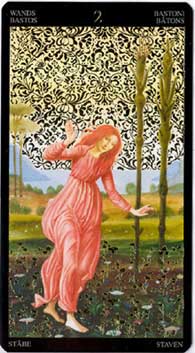 The Italian tarot manufacturers Lo Scarabeo in Torino have recently presented their catalogue for 2008.
As usual, we get an overview, not only of the newly published decks but also of those decks, which are planned
to be published later in the year and, I believe, all former decks they still have in stock. It comes to 112
A5-pages with all items illustrated in colour; it is not only tarot decks but also divination decks, playing cards
with a diversity of themes and various accessories like bags to hold the decks. From this variety, I have selected
three tarot decks to present here, more will follow in later issues:
The Italian tarot manufacturers Lo Scarabeo in Torino have recently presented their catalogue for 2008.
As usual, we get an overview, not only of the newly published decks but also of those decks, which are planned
to be published later in the year and, I believe, all former decks they still have in stock. It comes to 112
A5-pages with all items illustrated in colour; it is not only tarot decks but also divination decks, playing cards
with a diversity of themes and various accessories like bags to hold the decks. From this variety, I have selected
three tarot decks to present here, more will follow in later issues:
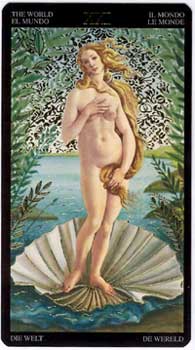 The Golden Botticelli Tarot
The Golden Botticelli Tarot
We have already seen a number of tarot decks from Lo Scarabeo experimenting with a printing technique,
which allows for adding a metallic foil, either gold or silver, during the printing process. They are
published in the category which Lo Scarabeo call "art tarots". Most of them are decks based upon antique
tarot decks like the Visconti tarot and the Mantegna tarot, or on works by famous artists like Gustav Klimt.
In these decks the golden areas were relatively large and connected. In the `Golden Botticelli Tarot'
based upon the art and style of the Florentine painter Alessandre Filipepi, known as Sandro Botticelli,
all cards have a very large number of tiny single elements, like dots, thin lines and free flowing leaves,
adorned with gold, which are twinkling, when the card is tilted. During the printing process a special
transparent template is carefully created by cutting away the areas, where the gold foil shall be placed,
similar to the process used for high quality screen printing.
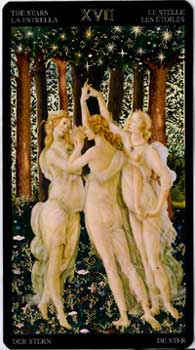
Unfortunately, the little white booklet does not give us much information. I would have liked to see
references to those of Botticelli's works which inspired the single cards (or at least some of them);
some are obvious, like `The Stars', which is a detail from "La Primavera" and `The World', depicting
Botticelli's "Birth of Venus". Many characters and features can be recognized from Bottticelli's
religious paintings, but it takes a lot more knowledge of Botticelli's art, than I have, to identify the
majority of the images, and maybe we can't even find them in Botticelli's own works, but rather in works by
other painters from the time? No information is given on that either. Actually, the accompanying text is only
of about 100 words plus 11 pages of divinatory trivialities. These 11 pages could have been used much better!
When will main stream tarot publishers realize, that these divination texts are completely superfluous?
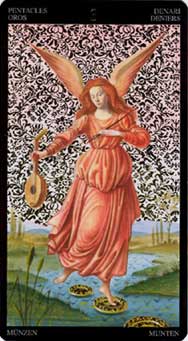 Anyway, the illustrator, Atanas Alexandrow Atanassov is competent and has certainly done a good job. The
picture area is well made use of. The black framing emphasizes the images. The printing is perfect. The
illustrations shown here do, of course, not give justice to the glittering and twinkling images.
Not even if they had been in colour; the glittering and glow would still be missing. Regardless whether
you are a tarot collector or not, you should give yourself the pleasure to see just one of Lo Scarabeo's
gold imprinted decks. Amazingly, they are not expensive, the price is about EUR25.-, while the ordinary
decks from Lo Scarabeo cost about EUR20.-
Anyway, the illustrator, Atanas Alexandrow Atanassov is competent and has certainly done a good job. The
picture area is well made use of. The black framing emphasizes the images. The printing is perfect. The
illustrations shown here do, of course, not give justice to the glittering and twinkling images.
Not even if they had been in colour; the glittering and glow would still be missing. Regardless whether
you are a tarot collector or not, you should give yourself the pleasure to see just one of Lo Scarabeo's
gold imprinted decks. Amazingly, they are not expensive, the price is about EUR25.-, while the ordinary
decks from Lo Scarabeo cost about EUR20.-
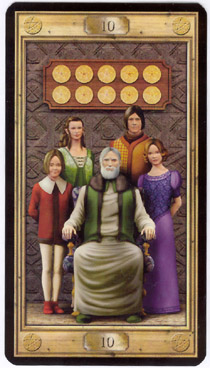
The Pictorial Key Tarot
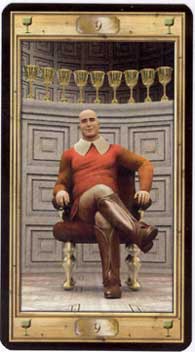 The title of this deck does, of course, refer to Arthur E. Waite's accompanying book to the Waite-Smith
tarot, as it was published with Pamela Colman Smith's illustrations in 1911. I suppose that Lo Scarabeo
will classify it in their "occult tarot' category. The `Pictorial Key Tarot' is another unsuccessful -
almost painful - attempt to recreate the Waite-Smith Tarot. The designer, in this case I suppose, that
Lo Scarabeo means `the illustrator' but I am not sure, by name of Davide Corsi, working `under the
supervision of Lo Scarabeo's editorial team' as the booklet states, has made a deck populated with
characters, which give associations to the wax figures exhibited in `Madame Tussaud's wax-museum and
similar places. Stiff, impersonal figures with dead eyes. Zombies or the living dead, as we can find them
popping up in horror films. The most remarkable are the glaring and staring dead eyes. To illustrate
this I have enlarged a few of them to be compared with the real thing, Colman Smith's faces from
1909/10. Is `The Pictorial Key Tarot' really the result of Lo Scarabeo's supervision? `A highly
evolved representation of the Pictorial Key', the booklet additionally states. As so often is the case, the text
in the booklet is mediocre and unnecessary. I wonder what ideas Lo Scarabeo had for manufacturing this
deck? A mass media tarot producer shall, of course, have decks to offer for all sorts of tastes, including
bad and maybe it was meant as a competitor to US Games horrible `Radiant Tarot'? I really did not
expect Lo Scarabeo to use their valuable time to send a deck like this on the market. They have so
many exciting projects waiting, so why this one?
The title of this deck does, of course, refer to Arthur E. Waite's accompanying book to the Waite-Smith
tarot, as it was published with Pamela Colman Smith's illustrations in 1911. I suppose that Lo Scarabeo
will classify it in their "occult tarot' category. The `Pictorial Key Tarot' is another unsuccessful -
almost painful - attempt to recreate the Waite-Smith Tarot. The designer, in this case I suppose, that
Lo Scarabeo means `the illustrator' but I am not sure, by name of Davide Corsi, working `under the
supervision of Lo Scarabeo's editorial team' as the booklet states, has made a deck populated with
characters, which give associations to the wax figures exhibited in `Madame Tussaud's wax-museum and
similar places. Stiff, impersonal figures with dead eyes. Zombies or the living dead, as we can find them
popping up in horror films. The most remarkable are the glaring and staring dead eyes. To illustrate
this I have enlarged a few of them to be compared with the real thing, Colman Smith's faces from
1909/10. Is `The Pictorial Key Tarot' really the result of Lo Scarabeo's supervision? `A highly
evolved representation of the Pictorial Key', the booklet additionally states. As so often is the case, the text
in the booklet is mediocre and unnecessary. I wonder what ideas Lo Scarabeo had for manufacturing this
deck? A mass media tarot producer shall, of course, have decks to offer for all sorts of tastes, including
bad and maybe it was meant as a competitor to US Games horrible `Radiant Tarot'? I really did not
expect Lo Scarabeo to use their valuable time to send a deck like this on the market. They have so
many exciting projects waiting, so why this one?
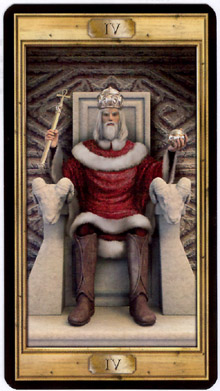
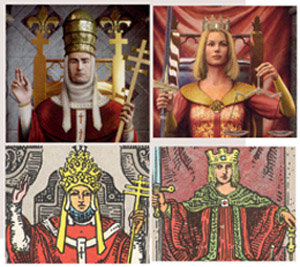
Zodiac Tarot
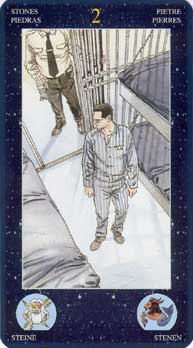 Zodiac Tarot, with the subtitle `The first true astrological Tarot Cards', is a creation by Lee Bursten,
whom we know from his `Gay Tarot', likewise published by Lo Scarabeo (see
my review
in TPC, vol.33, #3, January-March 2005).
Zodiac Tarot, with the subtitle `The first true astrological Tarot Cards', is a creation by Lee Bursten,
whom we know from his `Gay Tarot', likewise published by Lo Scarabeo (see
my review
in TPC, vol.33, #3, January-March 2005).
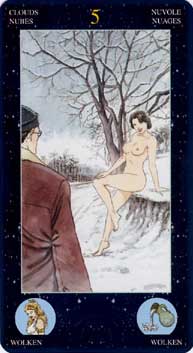 The artwork is by Luca Raimondo in a drawing style which I will refer to as `the comic book school'.
In their 20 years anniversary book Lo Scarabeo presents `Zodiac Tarot' under the headline of
"metaphysical tarots" and notes, that the deck is ...depicting planets as people and (astrological)
Houses as places... Quite a useful information to have when one starts to look at the images. The
majors are each assigned to one of the 12 astrological signs or to one of the ten planets, here deviating
from the Golden Dawn tradition since the "new" planets, Uranus, Neptune and Pluto were not a part of the
Golden Dawn attributions. Each of the 22 major- or trump cards depict "places". The traditional qualities
of the astrological signs (cardinal, fixed or mutable) are illustrated; so to say build into the image by
letting it express various hours of the day: daytime, nighttime or sunrise/sunset. Those majors, who
symbolize the planets, depict seven people as we find them in a traditional upper-class American family:
grandfather/-mother, the parents, a son and a daughter and a baby, wherever she/he comes from? I have, btw,
only rarely seen such an ugly child. The three new planets are represented by cards depicting social changes.
We find the same characters - persons - again, inhabiting and being active inside the four series of number
cards, where the suits are called Torches, Waves, Clouds and Stones respectively. Some of the illustrations
are rather confusing. We can make the guess that the father is an attorney at court, but does the son live
in a submarine and the grandparents in an camper? Who is that guy being lock up in a prison on `two
of stones'? The son? Or who is it that gets a glimpse of a naked woman sitting on a snow shelf? The father,
the son? A plot is not settled, probably with the purpose to allow the `card reader' to create her own
stories. On top of all this, the poor `reader' has additionally to observe the non-illustrative court cards,
which represent the elements, and likewise those of the number cards, which represents the 32 decanates of
the Zodiac with their respective `planetary rulers'. Its all part of the system, which is said to be
...An intuitive method for combining Tarot cards and astrology for getting to know these two worlds...as
it is stated on the box . Imo it is a rather strained construction and I do not really know, who it is meant for.
The artwork is by Luca Raimondo in a drawing style which I will refer to as `the comic book school'.
In their 20 years anniversary book Lo Scarabeo presents `Zodiac Tarot' under the headline of
"metaphysical tarots" and notes, that the deck is ...depicting planets as people and (astrological)
Houses as places... Quite a useful information to have when one starts to look at the images. The
majors are each assigned to one of the 12 astrological signs or to one of the ten planets, here deviating
from the Golden Dawn tradition since the "new" planets, Uranus, Neptune and Pluto were not a part of the
Golden Dawn attributions. Each of the 22 major- or trump cards depict "places". The traditional qualities
of the astrological signs (cardinal, fixed or mutable) are illustrated; so to say build into the image by
letting it express various hours of the day: daytime, nighttime or sunrise/sunset. Those majors, who
symbolize the planets, depict seven people as we find them in a traditional upper-class American family:
grandfather/-mother, the parents, a son and a daughter and a baby, wherever she/he comes from? I have, btw,
only rarely seen such an ugly child. The three new planets are represented by cards depicting social changes.
We find the same characters - persons - again, inhabiting and being active inside the four series of number
cards, where the suits are called Torches, Waves, Clouds and Stones respectively. Some of the illustrations
are rather confusing. We can make the guess that the father is an attorney at court, but does the son live
in a submarine and the grandparents in an camper? Who is that guy being lock up in a prison on `two
of stones'? The son? Or who is it that gets a glimpse of a naked woman sitting on a snow shelf? The father,
the son? A plot is not settled, probably with the purpose to allow the `card reader' to create her own
stories. On top of all this, the poor `reader' has additionally to observe the non-illustrative court cards,
which represent the elements, and likewise those of the number cards, which represents the 32 decanates of
the Zodiac with their respective `planetary rulers'. Its all part of the system, which is said to be
...An intuitive method for combining Tarot cards and astrology for getting to know these two worlds...as
it is stated on the box . Imo it is a rather strained construction and I do not really know, who it is meant for.
|